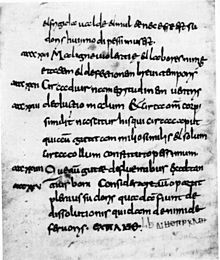
Content edit
Epidemics 1 edit
In Epidemics 1, it begins by describing each season’s characteristics. The season autumn; described by strong south winds and many rainy days. Winter had south winds with the occasional north wind, and droughts. Spring was southerly and cold with slight rain. Summer was cloudy and didn’t rain.[1] Starting in the spring, many people began having mild fevers and in some, it caused hemorrhage. The hemorrhage was rarely fatal and only accounts for very few deaths. Swelling next to both ears was also a common occurrence. Coughs and sore throats accompanied the other symptoms.[2] Based on modern knowledge about various diseases, it is clear that the swelling next to the ears was mumps. This is known because mumps causes swollen salivary glands that are located under the ears and the descriptions in the Hippocratic Corpus were so vivid that even over a thousand years later, the symptoms could be identified.[3] The fever and cough can simply be associated with allergies or the common cold, although it cannot be for certain. Epidemics 1 goes on to describe the climate in two different occasions with the illnesses associated with them, called Constitutions. Some of the symptoms include more serious, sometimes lethal fevers, eye infections, and dysentery.[1]
On Diseases edit
Jaundice is a disease that is mentioned numerous times throughout and is described as occurring in five different ways. Jaundice is when the skin or eyes turn yellow.[4] The Greek physicians thought of Jaundice to be a disease itself rather than what medical professionals know now to be a symptom of various other diseases. The Greeks also believed that there were five different kinds of jaundice that can occur and report the differences between them.[5]
The first kind can quickly turn fatal. The skin appears to be green. The analogy made in the text is that the skin is greener than a green lizard.[5] The patient will have fevers, shiver, and the skin becomes very sensitive. In the mornings, sharp pains occur in the abdominal region. If the patient survives more than two weeks, they have a chance of recovery. The treatments suggest drinking a mixture of milk and other nuts and plants in the morning and at night. The second form develops only during the summer because it was believed the heat of the sun causes bile, a dark green fluid produced by the liver, to rest underneath the skin. This causes a yellowish color to the skin, and pale eyes and urine. The scalp also develops a crusty substance. The treatment calls for several baths a day on top of the mixture mentioned in the first remedy. Surviving past two weeks with this form of jaundice was rare. In two other forms of this disease, occurring during the winter, set in due to drunkenness, chills, and the excess production of phlegm. The last form is the least fatal and most common. It is associated with eating and drinking too much. The symptoms include yellow eyes and skin, fever, headache, and weakness.[5] The treatment however, it very different from the rest. The physician will draw blood from the elbows, and advise to take hot baths, drink cucumber juice, and induce vomiting to clear the bowels. If the treatment is followed, a full recovery is possible.[6] The several forms of jaundice that the Greek physicians proclaimed might be because jaundice occurs due to varying sicknesses like hepatitis, gallstones and tumors. The diverse set of symptoms were probably the effects of the sicknesses rather than the jaundice itself.
Empyemas in the Hippocratic Corpus edit
An empyema is a Greek word derived from the word “empyein” which means “pus-producing.”[7] According to the Hippocratic Corpus, they can occur in the thorax, the uterus, the bladder, the ear, and other parts of the body.[8] However, the writings indicate that the thorax was the most common and provided more description. Physicians at the time thought that the cause of an empyema was by orally ingesting some form of foreign body where it will enter the lungs. This could be done by inhaling or drinking the foreign body. The physicians also thought that empyemas could occur after parapneumonic infections or pleurisy because the chest has not recovered from those illnesses.[8] Parapneumonic infections can be tied to modern pneumonia which can still be fatal.
There are many symptoms associated with an empyema ranging from mild to severe. The most common ones are fever, thoracic pain, sweating, heaviness in the chest, and a cough.[8] Treating an empyema was primarily done using herbal remedies or non-invasive treatments. Mostly mixtures of different plants and organic matter were drank or bathed in. There are a few extreme cases in which invasive procedures were performed and mentioned in detail. One of these treatments included the patient behind held down in a chair while the physician cut between the ribs with a scalpel and inserted a drainage tube which would remove all of the pus.[8] The research and descriptions that the Greek physicians performed were so accurate that they were the foundation of what we know about empyemas today.
References edit
- ^ a b Jones, W. H. S. (1923). Hippocrates, with and English Translation by W. H. S. Jones. London: Heinemann. pp. 147–150, 472–473.
- ^ Craik, Elizabeth (2015). The 'Hippocratic Corpus' : Content and Context. London: Routledge. ISBN 9781138021716.
- ^ "Mumps". cdc.gov. Retrieved 2019-11-13.
{{cite web}}: CS1 maint: url-status (link) - ^ "Jaundice". medlineplus.gov. Retrieved 2019-11-13.
- ^ a b c Papavramidou, Niki; Fee, Elizabeth; Christopoulou-Aletra, Helen (2007-11-13). "Jaundice in the Hippocratic Corpus". Journal of Gastrointestinal Surgery. 11 (12): 1728–1731. doi:10.1007/s11605-007-0281-1. ISSN 1091-255X.
- ^ Nutton, Vivian. (2004). Ancient medicine. London: Routledge. ISBN 0415086116. OCLC 53038721.
- ^ "Definition of Empyema". MedicineNet. Retrieved 2019-11-13.
{{cite web}}: CS1 maint: url-status (link) - ^ a b c d Christopoulou-Aletra, Helen; Papavramidou, Niki (March 2008). ""Empyemas" of the Thoracic Cavity in the Hippocratic Corpus". The Annals of Thoracic Surgery. 85 (3): 1132–1134. doi:10.1016/j.athoracsur.2007.11.031.